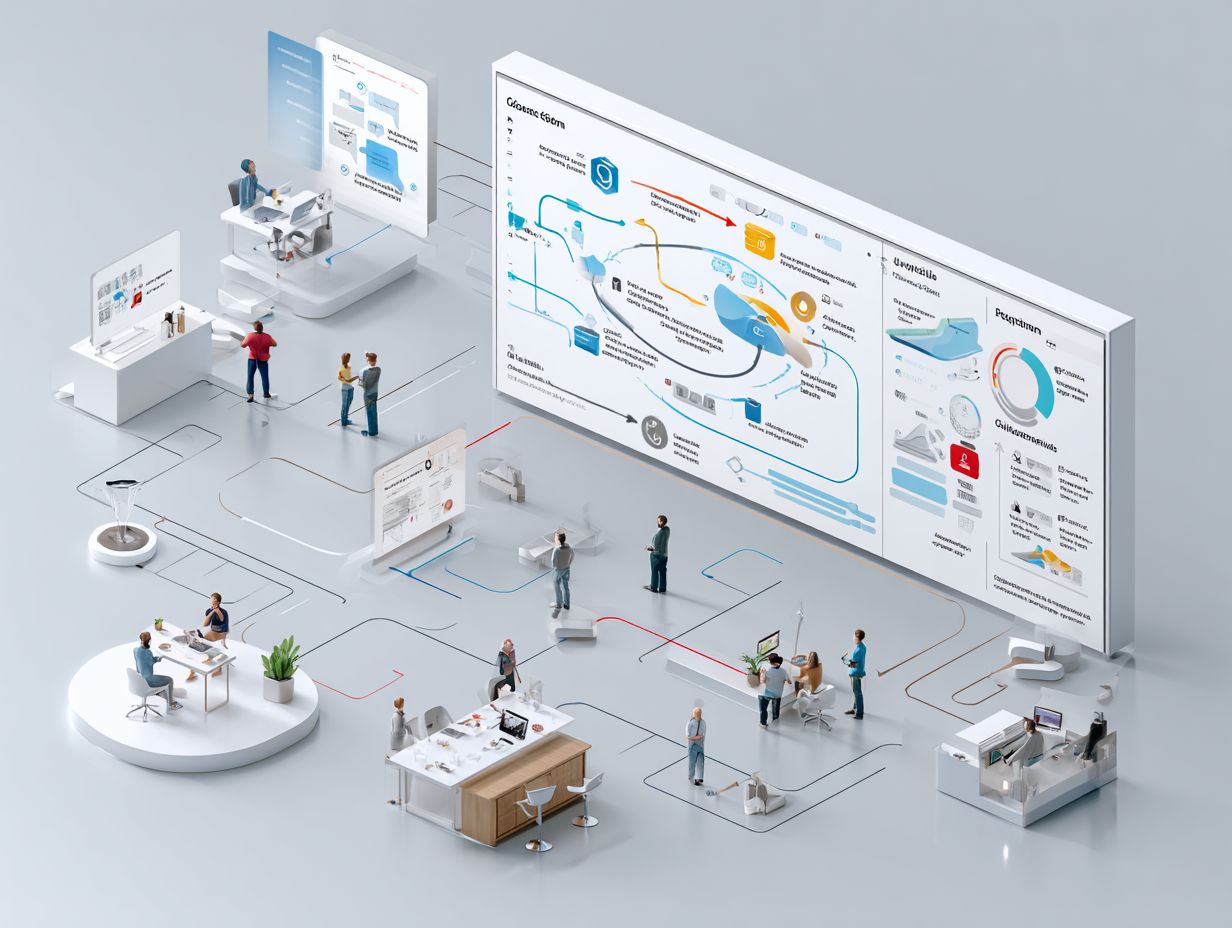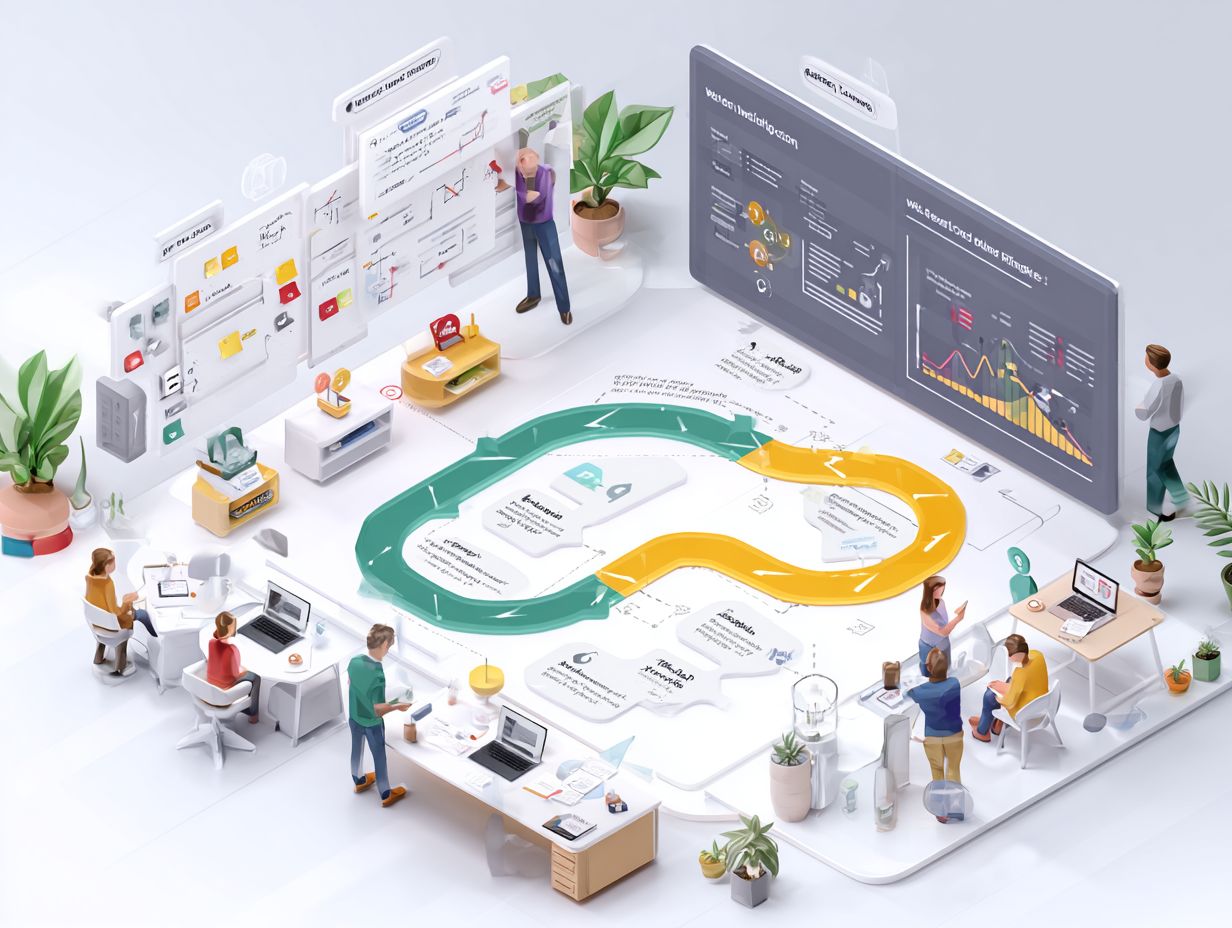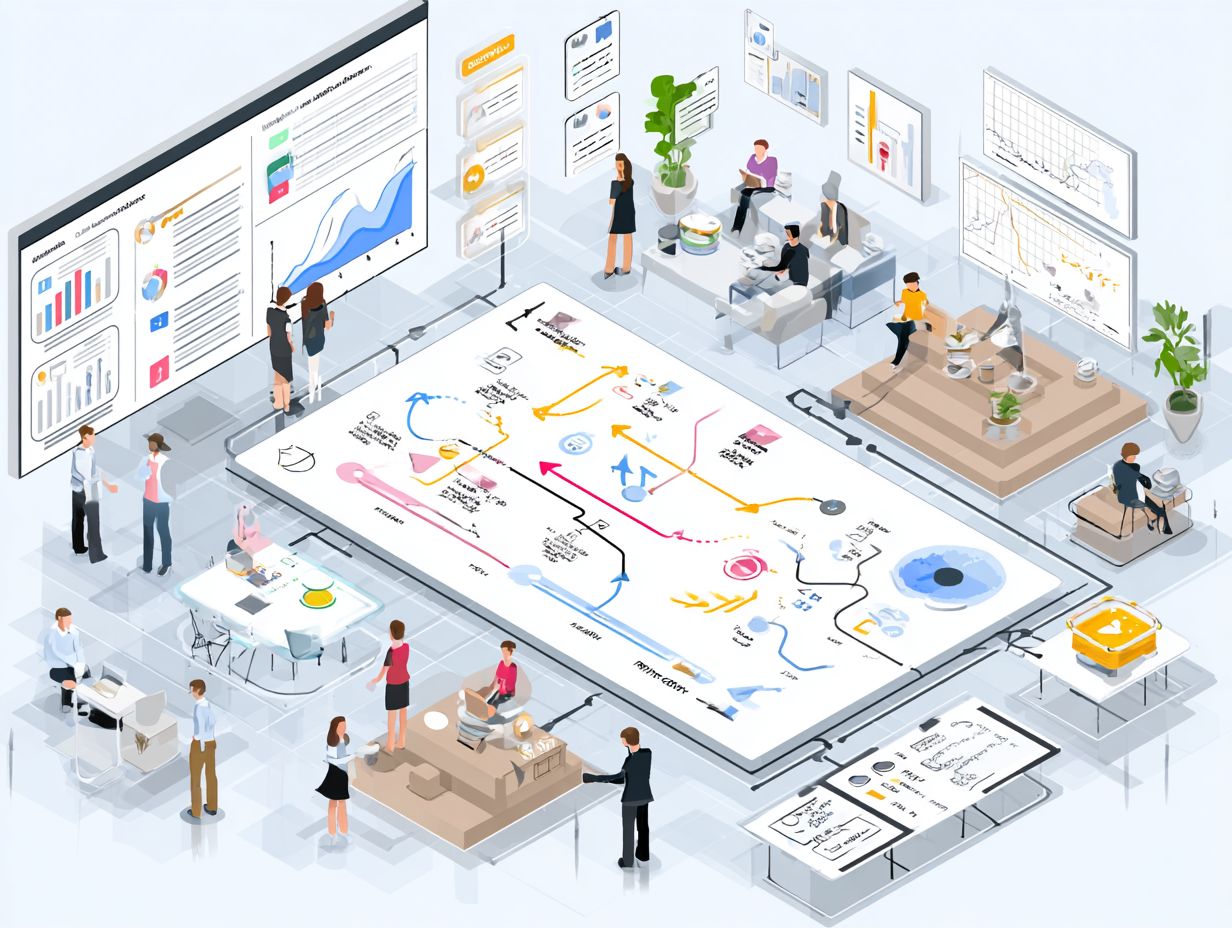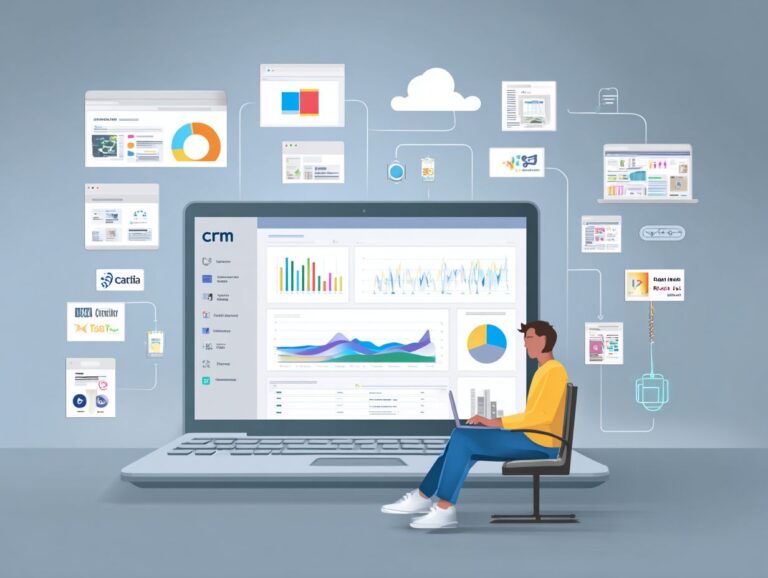Customer Journey Mapping: Benefits and CRM Integration
Mapping out the customer experience can strengthen your CRM plan and enhance your services for customers. By studying how customers act and using their data well, businesses can create personalized interactions that connect with their audience. This article will explain the benefits of mapping the customer experience, examine how to connect it with CRM systems, and provide practical advice to make your customer experience better. Get ready to keep more customers and make wise decisions!
Key Takeaways:
- Mapping the steps a customer takes helps businesses learn more about their customers and make their experience better.
- Connecting customer journey mapping with CRM systems can help keep customers, improve decisions, and provide custom experiences.
- To make a useful map of the customer experience, companies should think about customer types, points of contact, and privacy issues related to data.
- Benefits of Customer Journey Mapping
- Connecting CRM Systems with Tracking Customer Experience
- Steps to Create a Customer Journey Map
- Challenges and Considerations
- Frequently Asked Questions
- 1. What is customer journey mapping and how does it help businesses?
- 2. How does knowing a customer’s experience assist in connecting CRM systems?
- 3. How can mapping the customer experience help keep customers loyal?
- 4. Can mapping customer experiences help businesses find areas for growth?
- 5. How does combining CRM with customer journey mapping make business communication better?
- 6. What are the lasting benefits of using customer journey mapping and connecting it with CRM systems?
1. Definition and Importance

Customer journey mapping is a method where you draw a diagram to show how a customer communicates with a brand. This diagram helps to understand these interactions and improve them. This method allows businesses to identify pain points and opportunities throughout each stage of the customer experience, from awareness to post-purchase.
To explore how customer experience differs from customer satisfaction, consider the insights in our detailed comparison guide. For example, tools like Lucidchart or Miro can show these paths, including interactions, emotions, and potential challenges.
By examining this data, companies can make processes more efficient, customize communications, and improve overall customer satisfaction. A thorough map helps marketing and sales teams plan their strategies and promotes cooperation across departments, ensuring everyone works together for improved customer interaction.
2. Key Components of the Customer Journey
The customer’s process includes important steps such as noticing the product, thinking about options, making a purchase, and their experience after buying.
During the awareness stage, potential customers recognize a problem or need. Here, using specific ads and interesting content is key. In the consideration phase, customers evaluate options, often relying on reviews and detailed product descriptions to inform their choices. It’s essential to highlight unique features and benefits that set your offering apart.
The decision stage is where friction points arise, so providing clear pricing, guarantees, or testimonials can ease concerns. After buying, sending surveys and creating loyalty programs can build lasting connections and motivate customers to buy again.
Benefits of Customer Journey Mapping
Mapping out the steps customers take can improve their experiences and help keep them coming back. For B2B businesses, mastering customer experience is crucial, as mentioned in our ultimate guide.
1. Enhanced Customer Experience
By finding problems and improving areas where customers interact with the business, companies can make the customer experience better, leading to more satisfaction and loyalty.
Starbucks analyzed the steps customers take when picking up mobile orders to find delays. After organizing, they made store operations smoother and made app notifications better, which increased customer satisfaction scores by 15%.
Tools like Miro and Lucidchart help teams create clear visual diagrams of these processes. Start by describing each part of the customer experience, beginning with opening the app and ending with finishing their order. This helps find problem areas and make improvements based on what customers say.
2. Improved Customer Retention
By creating maps of customer experiences, companies can keep 20% more customers by concentrating on particular ways they engage with them.
A big retail company did a case study and found problems in their online checkout process by tracking how customers interacted. They reduced the number of abandoned carts by simplifying the user experience and sending personalized follow-up emails.
Tools like Miro or Smaply provide a clear view of the process, making it easy for teams to evaluate and change based on feedback. This organized method retains customers and strengthens brand loyalty by recognizing customer needs.
3. Informed Decision-Making

Mapping out the customer’s path gives companies useful information to make decisions based on data, improving their marketing and sales plans. By looking at customer actions and feedback, businesses can identify problems in the experience.
For instance, using tools like Hotjar can reveal where users drop off on a webpage, while Google Analytics provides data on engagement rates.
After identifying these areas, organizations may use A/B testing with Optimizely to test various website designs or messages. These specific changes make the customer experience better, leading to more purchases and stronger customer loyalty.
Connecting CRM Systems with Tracking Customer Experience
Integrating CRM systems with customer journey mapping reveals how customers interact, which helps improve marketing strategies. For a comprehensive understanding of how these interactions can boost sales and retention, explore our effective customer experience marketing strategies.
1. What is CRM Integration?
CRM integration is the process of linking customer relationship management software with other tools to simplify data handling and improve interactions. This connection is important for keeping track of customer paths precisely, allowing companies to follow customer activities completely.
For example, using Salesforce along with marketing tools like HubSpot can automatically send follow-up messages based on what users do. By setting triggers in these platforms, you can create targeted email campaigns that respond to specific actions, such as abandoned carts or recent purchases.
This system improves response times and makes sure customers get useful information, which makes their experience better and builds loyalty.
2. Benefits of CRM Integration
Connecting CRM systems helps map customer interactions by offering detailed information about customers, resulting in better communication and growth plans.
To make the most of CRM for mapping customer experiences, begin by using tools like HubSpot or Salesforce to divide customers based on their actions.
For instance, HubSpot enables tracking user interactions across touchpoints such as social media, email, and website visits, creating a detailed profile. Employ analytics tools like Google Analytics to gauge engagement metrics. This full overview can help develop personalized marketing strategies. For instance, a company increased customer retention by 30% after changing campaigns based on data from CRM systems.
Steps to Create a Customer Journey Map
Building a customer journey map involves identifying various customer groups and outlining where they engage with the business. Understanding these interactions can be quite complex. For those interested in exploring how different organizational structures impact customer experiences, you might find our insights on customer experience organizational structures particularly enlightening.
1. Identify Customer Personas

Defining customer personas is essential as it allows businesses to tailor their marketing strategies to meet individual customer needs.
To create detailed customer personas, start by analyzing data from tools like Google Analytics and HubSpot. Identify demographics such as age, gender, and location, and then look at behavior patterns like page views, bounce rates, and purchase history.
For instance, a retail company might find that its primary audience is women aged 25-34 who frequently shop via mobile devices. This knowledge helps create campaigns that focus on improving content for mobile devices and customizing the material.
Regularly refresh these personas with new data to keep up with shifting customer behaviors.
2. Map Customer Touchpoints
Mapping customer touchpoints means identifying all interactions between a customer and a brand, ensuring that every significant experience is captured. To effectively map these touchpoints, use tools like Miro or Lucidchart to visually organize interactions.
Start by listing all possible touchpoints-consider both online avenues like social media, websites, and emails, alongside offline channels such as in-store experiences and customer service calls.
Next, create a checklist to evaluate each touchpoint’s impact and effectiveness, asking questions like:
- ‘Does it meet customer expectations?’
- ‘Is it consistent with our brand message?’
This process carefully examines each part and identifies areas for improvement.
Challenges and Considerations
Mapping customer experiences has many advantages, but it also has some difficulties that companies should think about. For those interested in boosting sales and retention, exploring effective customer experience marketing strategies can provide valuable insights.
1. Data Privacy Concerns
Protecting personal information is critical when collecting and analyzing customer data for mapping their experiences.
To follow rules like GDPR, businesses must take active measures.
- First, implement a clear consent mechanism so customers know how their data is used.
- Next, use tools like OneTrust to handle consent and keep records of user choices up to date.
- Regular data reviews are important; think about using tools like TrustArc to automatically check for compliance.
- Also, provide transparency by clearly informing customers about their data rights.
By following these steps, companies can handle the challenges of data privacy while improving their efforts in mapping the customer experience.
2. Maintaining Accurate Data
Having correct data is important for successful mapping of customer pathways, because errors can result in poor planning.
To keep your data correct, think about doing regular checks and using CRM tools like Zoho or Salesforce. Schedule quarterly reviews to compare your collected data against reliable industry benchmarks. Use tools like NeverBounce to verify email lists and Google Analytics to identify variations in website data.
Teaching your team effective data entry methods reduces mistakes, and creating automatic alerts for unexpected data can quickly point out errors. These methods work together to maintain the accuracy and consistency of data.
Frequently Asked Questions

1. What is customer journey mapping and how does it help businesses?
Customer journey mapping involves creating a visual chart that outlines the steps a customer goes through when interacting with a business, starting from their initial contact, making a purchase, and beyond. This allows businesses to understand their customers’ experiences and identify areas for improvement, leading to improved customer satisfaction and loyalty.
2. How does knowing a customer’s experience assist in connecting CRM systems?
Mapping out customer paths offers useful information about their experiences. This information can be added to a CRM system to make customer interactions better and tailor marketing strategies. By knowing the stage customers are at, businesses can adjust their communication and methods to address their particular needs and likes.
3. How can mapping the customer experience help keep customers loyal?
Mapping the customer path helps companies find problems and areas where customers are unhappy, so they can fix them and make the customer experience better. By addressing these issues, businesses can increase customer satisfaction and retention, leading to long-term customer loyalty and repeat business.
4. Can mapping customer experiences help businesses find areas for growth?
Yes, by learning about how customers interact with their products, businesses can spot missing elements and find new opportunities to grow. By looking at the buying process from the customer’s view, businesses can find new chances to sell more products or services, leading to higher sales and growth.
5. How does combining CRM with customer journey mapping make business communication better?
When businesses link customer path mapping with a CRM system, they keep all departments updated with the most current customer information. This leads to more efficient communication and collaboration, allowing all teams to work towards a common goal of improving the overall customer experience.
6. What are the lasting benefits of using customer journey mapping and connecting it with CRM systems?
Businesses can boost customer happiness and loyalty, raise sales and profits, and find new ways to grow by using tools like customer journey maps and linking them with CRM systems. It also makes the customer experience smoother and more effective, which helps the business over time.





